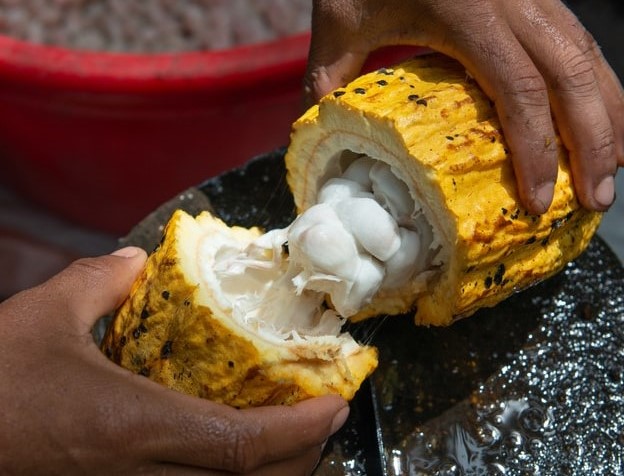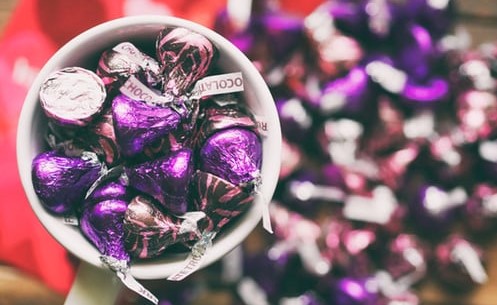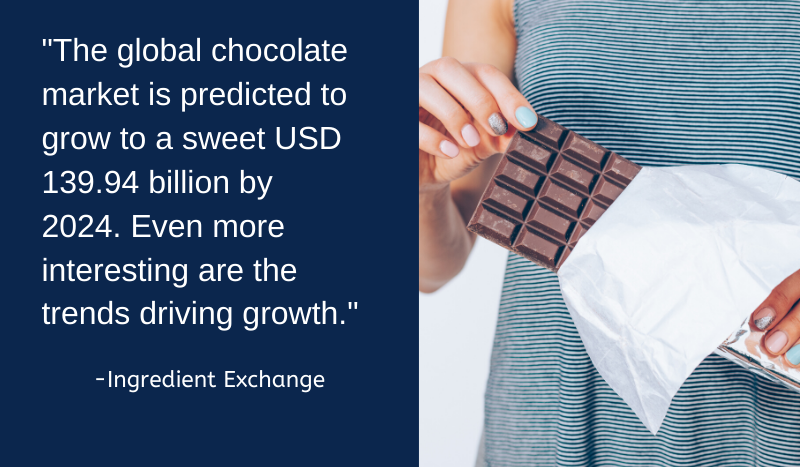Chocolate trends were most likely not top of mind this Valentine’s Day. Now that red heart-shaped boxes everywhere are empty, let’s look at what’s going on in the chocolate industry (did someone say chocolate cartel?)
1. The global chocolate market forecast
A look at chocolate goings-on wouldn’t be complete with some market analysis. According to a PRN Market Report summary, the global chocolate market is predicted to grow to a sweet USD 139.94 billion by 2024.
Even more interesting are the trends driving growth.
- Russia leads the European chocolate market pack (followed by Germany, the UK and France)
- More consumers are buying chocolate on impulse (really?). There seems to be an uptick in consumers slipping a candy bar between their kumquats and kombucha at the register. Contributing to the boost in chocolate sales are better check-out chocolate displays and vibrant packaging (purple, red and blue).
- Global chocolate giants (like Nestlé and Mondelez International) are staying competitive by going after untapped markets with new products (see #2).
2. The waste-not chocolate trend

For who knows how long, chocolate manufacturing has used only a tiny portion of the cacao pod — the seeds, leaving the majority of the fruit behind (in particular the pulp surrounding the cocoa beans).
South Americans have known for centuries that there was so much more to the cacao pod that just the beans. Some use the pulp to sweeten milk; others turn it into alcohol.
Ca Pao, the start-up brainchild of Monedelez and Barry Callebaut (think ruby chocolate), rescues the zesty pulp and combines it with dried fruits and nuts to create new, good-for-you snack products (smoothie balls and fruit jerky).
They’re also working on cacao-fruit chocolate.
However, competition is fierce.
Nestlé has developed cacao-fruit chocolate. The global food giant is staking its claim as the inventor of “the first 70% dark chocolate made entirely from the cocoa fruit and nothing else.”
Late 2019, they released a KitKat with Cocoa Fruit chocolate in Japan. The iconic KitKat wafer is coated in dark chocolate that uses only two ingredients: cocoa beans and the cacao-fruit pulp.
There’s a bonus: the sweetness of the pulp eliminates the need to add sugar.
3. COPEC: The new chocolate cartel

According to a recent Wall Street Journal article, Ivory Coast and Ghana are joining forces to create a cocoa cartel. This is a significant move, as together, the two African nations produce 60% of the world’s cocoa.
Nicknamed COPEC (like OPEC that controls global oil prices), the chocolate cartel plans to charge an additional $400 per metric ton of cocoa.
The price increase is sending a ripple through global chocolate markets that depend on the cartel’s almost three-quarters market share. With the new prices slated for October, some view the increase as a tax on the chocolate industry.
Moreover, the extra cash should raise cocoa farmers’ incomes as well as improve sustainability.
Consequently, prominent chocolate producers Mars, Mondelez and Hershey support the initiative for its positive social impact.
Of course, the cost increase has to show up somewhere eventually. Maybe in next year’s Valentine’s Day brightly wrapped, two-ingredient chocolates?
At Ingredient Exchange, we help food-industry clients rescue profits from their unusable inventory — including chocolate!
Please give us a call today to discuss turning your problem ingredients into cash: 314-872-8850
Image credits: 1) Rodrigo Flores (edited) 3) Aaron Burden (edited)



